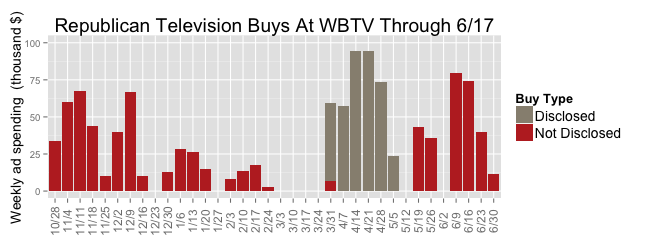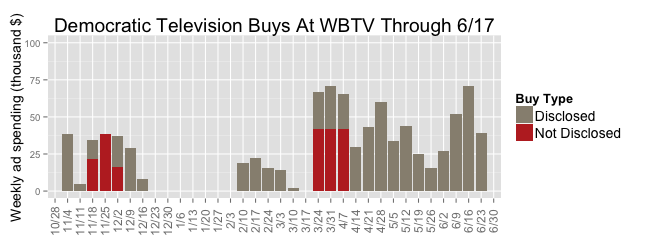Dark money in North Carolina’s Hagan-Tillis Senate race: 4,086 ad spots at WBTV
Outside groups bought virtually all the ads that one Charlotte TV station has aired in North Carolina’s hotly contested Senate race, and nearly half of the dollars they spent haven’t been reported to the Federal Election Commission. That’s the conclusion of a Sunlight analysis of all the ad orders received through mid-June at Raycom Media’s WBTV channel 3, located in the state’s most expensive media market.
The race between Democratic Sen. Kay Hagan and her Republican challenger, state House Speaker Thom Tillis, has attracted an enormous influx of money that is either impossible to trace to its source, or never reported to the nation’s campaign finance watchdog. Or both. Two of the nation’s biggest sources of undisclosed campaign money have combined to spend more than $10.5 million in the North Carolina Senate contest: Americans for Prosperity for at least $7 million and Crossroads GPS more than $3.5 million.
The undocumented campaign spending is perfectly legal: Federal law allows political groups incorporated as nonprofits to keep their donors secret. And ads can mention candidates in the most favorable or unfavorable terms without ever being reported the FEC as long as they don’t “expressly advocate” a vote for or against a candidate, and don’t run within the month prior to a primary election or two months prior to a general election.
Such ads amount to more than 65 percent of the Republican spending at WBTV. Here’s an example of one of the North Carolina ads that didn’t have to be declared to the FEC:
Such under-the-radar campaign spending can be quantified only by an analysis of TV ad buy contracts. Two years ago, the FCC required broadcast network affiliates in the nation’s 50 top TV markets to begin posting those contracts online; the Sunlight Foundation’s Political Ad Sleuth makes them searchable. This week, the database will expand ten-fold as an FCC order mandating all of the nation’s 2,000+ broadcast stations to begin online posting of political ad buys takes effect Tuesday.
Between the start of 2013 and June 17, WBTV had received orders for 4,086 political ads at a total cost of $3.8 million. About $3 million of that spending backs a candidate for Senate — either Hagan or Tillis.
Some of that $3 million includes ads booked through November; it’s expected that both candidates will order significant airtime at the end of the race but haven’t done so yet. This analysis, however, only includes Senate ads that had started airing by June 17, which represents orders for just over $2 million altogether.
The first buys Sunlight examined went up Oct. 30, 2013 — more than a year before Election Day.
The ads “just started coming in much earlier than in previous years,” said WBTV’s national sales manager, Patti Goodnight. “It’s been a constant drumbeat, really, since the first of the year,” added Goodnight. She also noted that the outside groups “took a little time off for the primary,” a fact that highlights one of the peculiarities of outside spending: Because groups have to report even “issue ads” that mention or depict candidates if they air within 30 days of a primary or 60 days of a general election, many outside groups tend to stop advertising during that period.
Here are six key takeaways:
1. Dark money is still a Republican game
Roughly 65% of WBTV ad dollars spent by Republican groups haven’t been reported to the Federal Election Commission. The dark money share is even higher when you consider the fraction of ads paid for by groups like the U.S. Chamber of Commerce that report money spent to the FEC, but don’t report their donors. Only 27% of Tillis-allied ads were underwritten by named donors. Those were paid for by the American Crossroads super PAC, and ran during the month before the May 6 primary.


The only left-leaning groups that didn’t disclose their spending to the FEC: The League of Conservation Voters, whose $76,700 ad buy ran from Nov. 21 through Dec. 4, and the Southern Alliance for Clean Energy, whose $126,000 buy aired Mar. 24 through April 13. It appears, however, that the clean energy alliance should have reported some of the spending to FEC, because some of those ads aired less than 30 days before the election.
2. Republicans lead spending in Charlotte, but not by much
Ads from Republican-allied groups (excluding about $16,000 in ads from two Republican primary candidates who lost) amounted to $1.14 million; Democratic spending — which includes two ad buys from Kay Hagan for $52,250 — came to $890,025. Marketwide estimates, which weren’t available for all buys, pointed to a similar breakdown among all Charlotte broadcasters.
3. Coordinated attack
Outside groups can’t coordinate with the candidate — but they can talk to each other. Despite a lengthy list of ad placements by multiple groups, there was remarkably little overlap by those playing on the same side. Among the anti-Hagan forces, Americans for Prosperity, Crossroads GPS, American Crossroads and the U.S. Chamber of Commerce never had ads running at the same time. Similarly, on the Democratic side, ads bought by Senate Majority PAC, Patriot Majority PAC and League of Conservation Voters never overlapped.
4. What hard money?
Tillis’ allies spent more than a million dollars at WBTV, and more than ten times that statewide. The candidate’s campaign committee, however, spent nothing at WBTV. Hagan’s campaign had just begun to air ads, with the first round going up June 10.
Candidates are guaranteed the lowest unit price beginning 60 days before the election, so it makes sense for them to wait to begin booking ad time, especially if there are other groups advertising on their behalf.
5. Republican-allied groups making Cadillac buys
Sort the 42 ad orders by gross cost per ad spot, and the top 14 orders are all from conservative groups. The priciest order, per spots, is from Americans for Prosperity and includes two 30-second spots for last December’s New York Jets vs Carolina Panthers NFL game at $12,000 an ad. The exception, however, is the group known as the 60 Plus Association. Targeting an older demographic is considerably cheaper.
6. More to come
Thus far only three groups have significant purchases in the final months — the most important part of the race — at WBTV. Crossroads GPS booked July 1-13 and July 22-31 for about $200,000 apiece throughout the Charlotte market.
We can guess at how much spending this represents statewide based on buys that have been disclosed, though of course, the fraction spent in Charlotte depends on the voters targeted. The U.S. Chamber of Commerce’s $900,000 buy boosting Tillis from April 30 to May 6 translated into a Charlotte market total of $279,000, for instance. And on the other side of the aisle, the Patriot Majority PAC’s roughly $300,000 buy Feb. 25 through March 10 amounted to just under $95,000 in Charlotte. (WBTV’s fraction of Charlotte spending appears to range from 19 to 54%, but is typically around 35%, according to documents).
The National Republican Senatorial Campaign and Democratic Senatorial Campaign Committee each have advance reservations for the final stretch of the race. The DSCC has already booked from Oct. 16 through Nov. 3, a seven-week stretch ending the day before Election Day, for about $2 million in the Charlotte market. The NRSC, however, so far has not committed to Tillis all the way through Election Day. So far the GOP Senate campaign committee has reserved only Sept. 2 through Oct. 13, a six-week stretch, for $1.2 million.
Presumably both sides will get considerable help from outside groups down the stretch, though they’ve avoided buying time thus far. “If they squeeze the market it doesn’t help the candidate,” said a Democrat-affiliated ad buying source.

